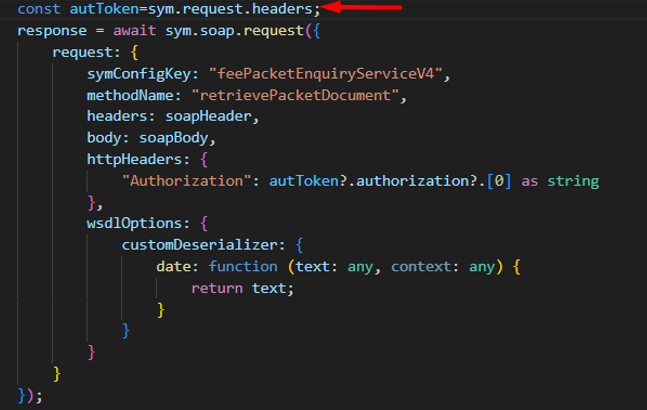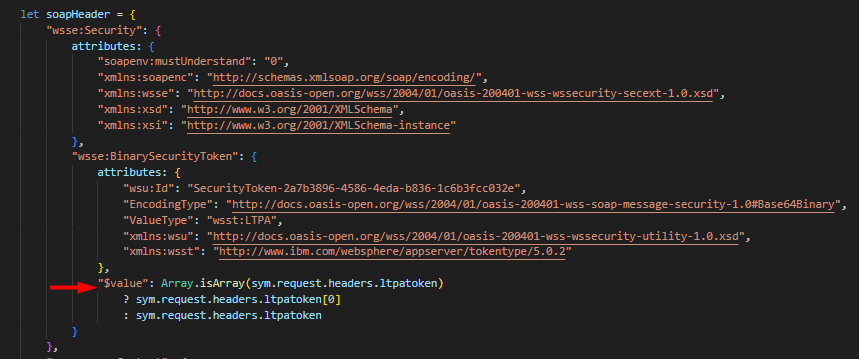Soap Information
Header Attributes Usage
The npm package can be used to create SOAP requests. For more detailed information, click Soap Npm Package
For Soap requests, a usage can be made as in the figure below.
You can add the following field to the request:
The namespace specified in the overrideRootElement is added to root tags as a prefix.
With the $attributes specified with attributesKey, the desired attributes are given in the header.

Example:
In Security, attributes can be added with $attributes as follows.
The written wsse namespace information is also added to the first level elements.

Http Headers
Bearer Token Usage
| Package | Version |
|---|---|
| symphony | @stechquick/symphony@0.3.4 |
| symphony-cli | @stechquick/symphony-cli@0.5.30 |
- In SOAP usages, when it is necessary to use httpHeaders within requests, the following usage can be applied.
- An example, In the SOAP request, the httpHeaders parameter is added as an Authorization key-value pair.
httpHeaders: {
"Authorization": "eyJhbGciOU5ENVNpZGNvIn0"
}

- It can also be used by retrieving it from the incoming request in the following way.

Ltpa Token Usage
- The following code structure can be used to obtain the Ltpa Token.
- The LTPA token can be obtained by adding the "$value" parameter. Example usage is provided below.

- The example code block, demonstrating the usage of Security, Consumer Context, and Ltpa Token within the Soap Header, is as follows:
let soapHeader = {
"wsse:Security": {
attributes: {
"soapenv:mustUnderstand": "0",
"xmlns:soapenc": "http://schemas.xmlsoap.org/soap/encoding/",
"xmlns:wsse": "http://docs.oasis-open.org/wss/2004/01/oasis-200401-wss-wssecurity-secext-1.0.xsd",
"xmlns:xsd": "http://www.w3.org/2001/XMLSchema",
"xmlns:xsi": "http://www.w3.org/2001/XMLSchema-instance"
},
"wsse:BinarySecurityToken": {
attributes: {
"wsu:Id": "SecurityToken-2a7b3896-4586-4eda-b836-1c6b3fcc032e",
"EncodingType": "http://docs.oasis-open.org/wss/2004/01/oasis-200401-wss-soap-message-security-1.0#Base64Binary",
"ValueType": "wsst:LTPA",
"xmlns:wsu": "http://docs.oasis-open.org/wss/2004/01/oasis-200401-wss-wssecurity-utility-1.0.xsd",
"xmlns:wsst": "http://www.ibm.com/websphere/appserver/tokentype/5.0.2"
},
"$value": Array.isArray(sym.request.headers.ltpatoken)
? sym.request.headers.ltpatoken[0]
: sym.request.headers.ltpatoken
}
},
"p:consumerContext": {
attributes: {
"xsi:type": "p:BranchContextType",
"xmlns:xsi": "http://www.w3.org/2001/XMLSchema-instance",
"xmlns:p": "http://isbank.com/Technical/EA/Header/Schema/V1"
},
"lang": "tr",
"consumerCode": "NAR.BKTUIALA",
"channelCode": "branch",
"ipAddress": sym.request.body.ipAddress,
"workstationName": sym.request.body.workstationName,
"organizationUnitCode": sym.request.body.organizationUnitCode
}
};
Array Usage
| Package | Version |
|---|---|
| symphony | @stechquick/symphony@0.3.3 |
| symphony-cli | @stechquick/symphony-cli@0.5.30 |
- The example usage for an array within SOAP requests is provided below. Let the request be as follows
{
"customerNumber": ["163288722","163141033"],
"includeAccounts":true
}
- In Symphony, the following usage can be applied for this request.
let soapBody = {
"tns:customerNumber": sym.request.body.customerNumber,
"tns:includeAccounts": sym.request.body.includeAccounts,
};